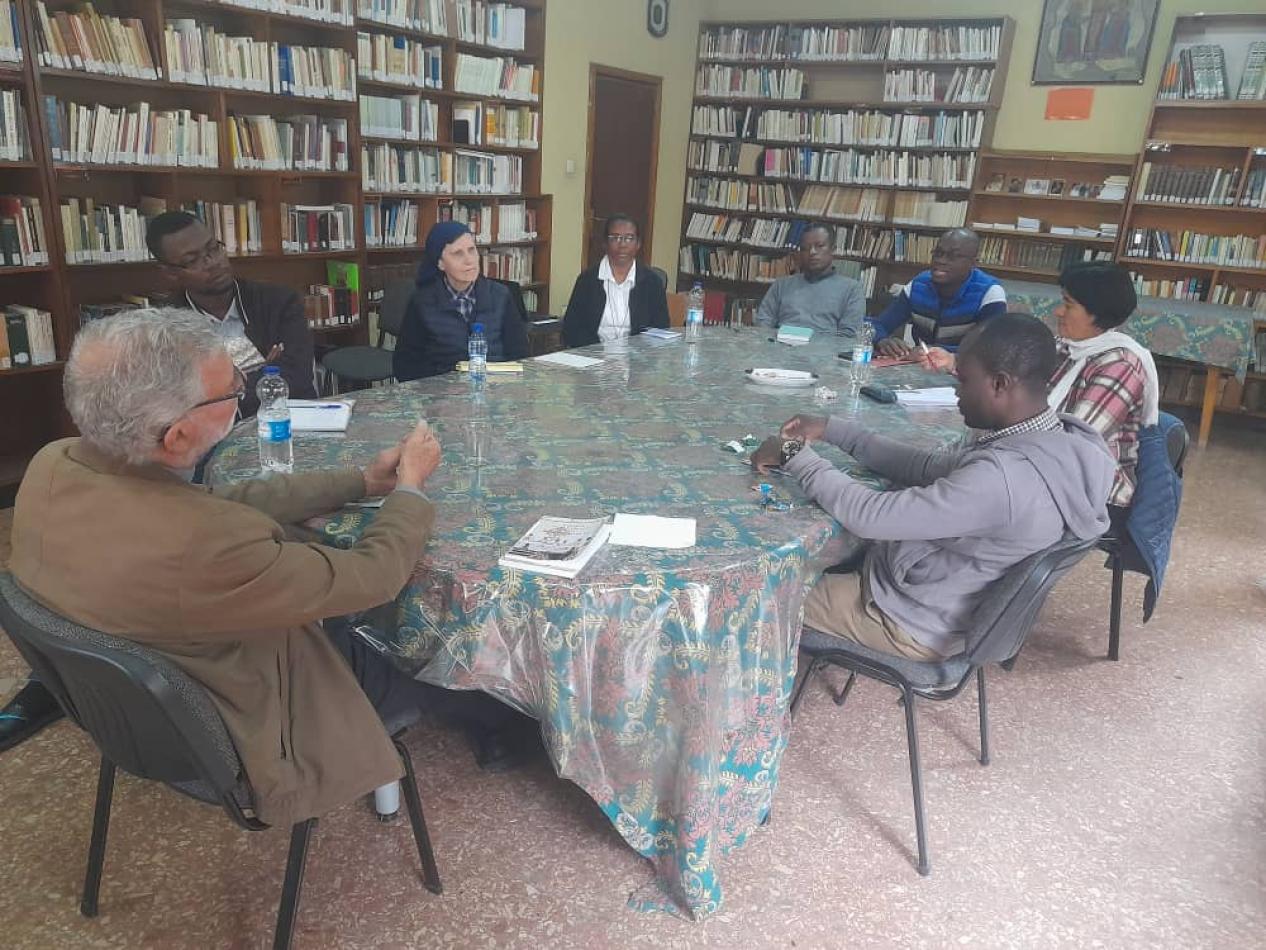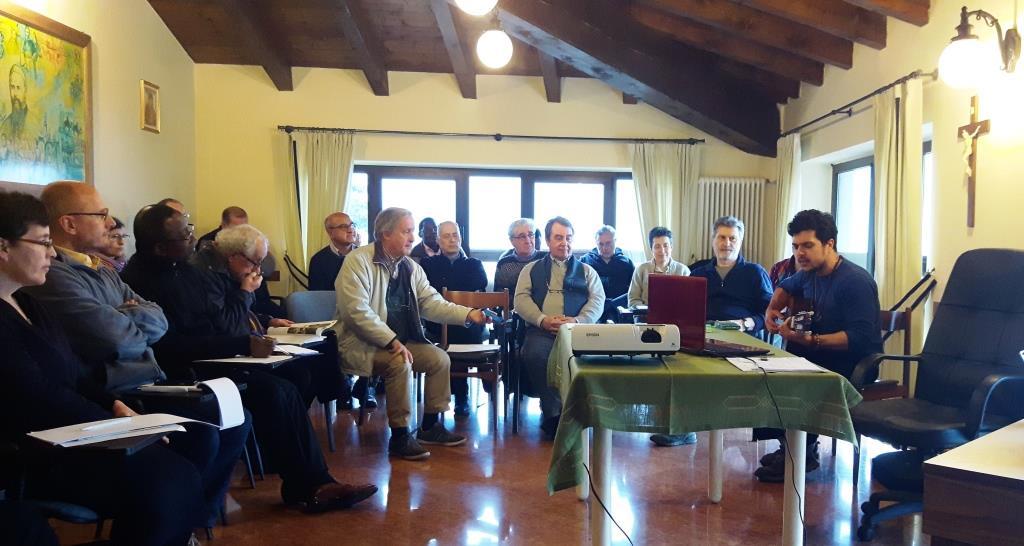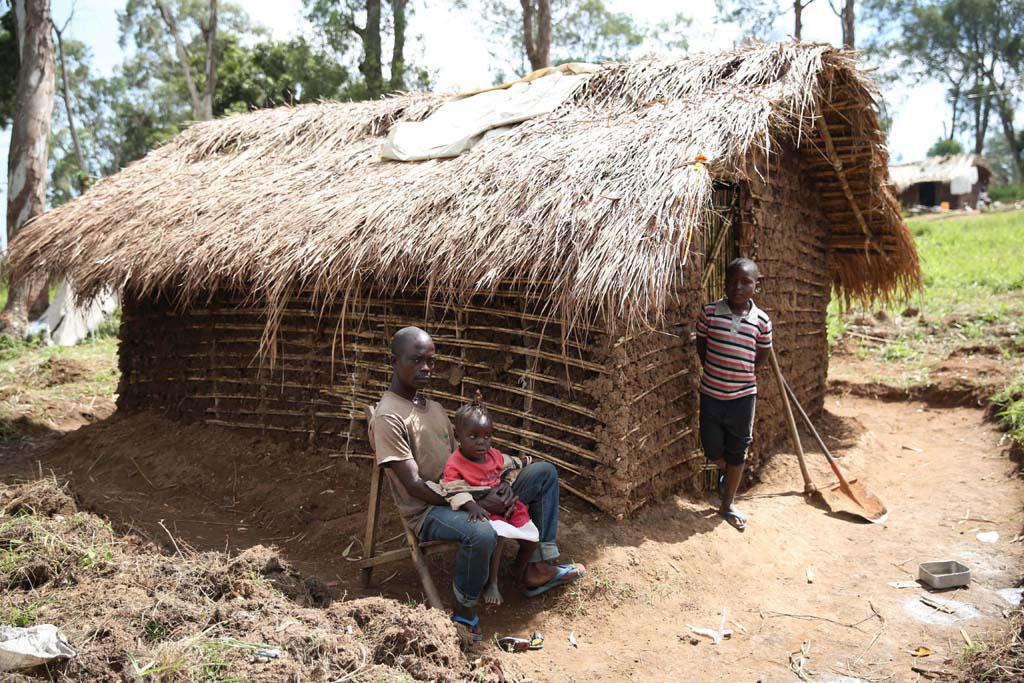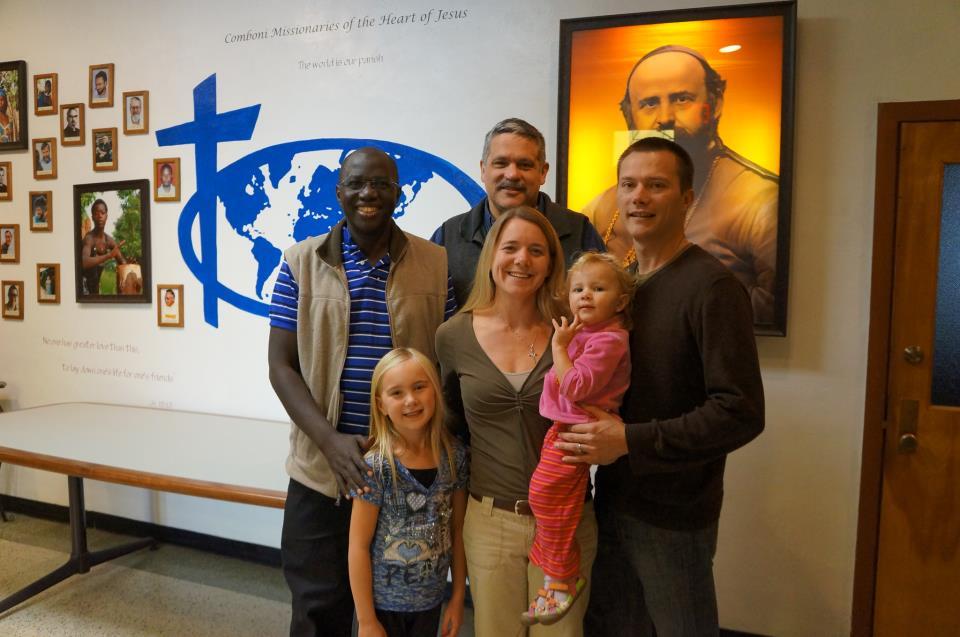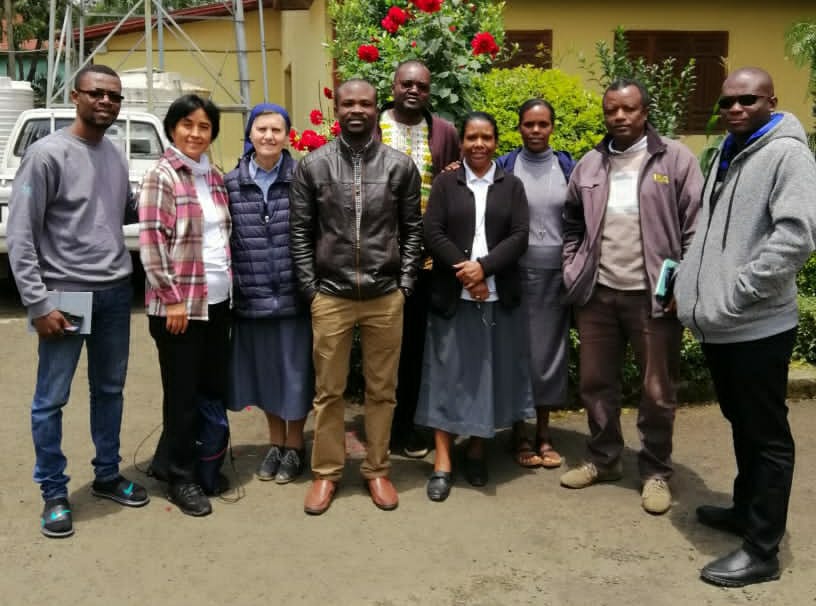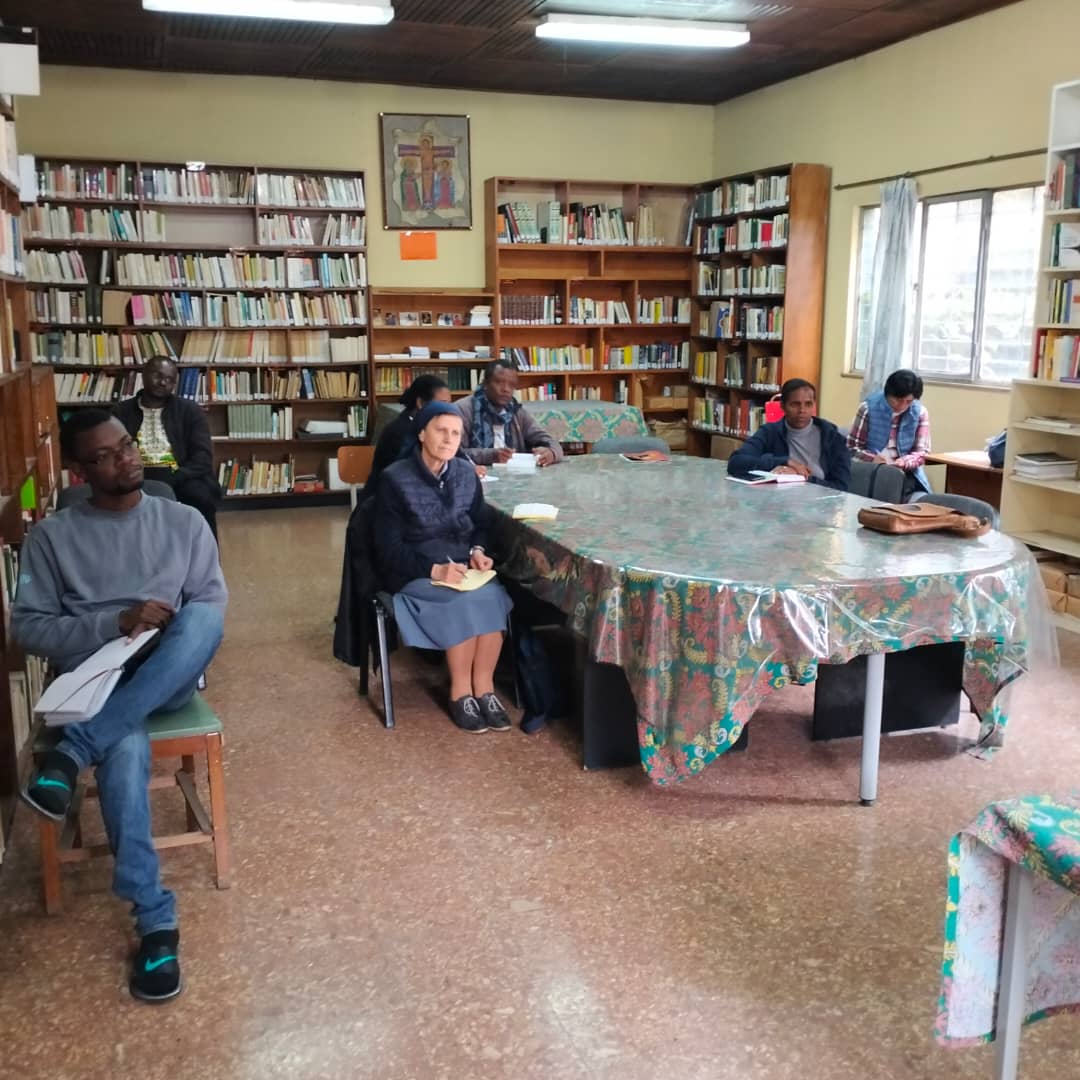Daniel Comboni
Comboni Missionaries
Institutional area
Other links
Newsletter
Friday, October 20, 2023
The Comboni Family (the Comboni missionaries and the Comboni missionary sisters) organised a course for the missionaries who had just arrived in Ethiopia. The event took place from 19th September to 22nd at the MCCJ Provincial House in Addis Abeba.
The course should have taken place more than a couple of years ago. However, the Covid-19 pandemic did not allow it to be organised. Finally, this year, the Comboni Family, through its formation secretariats, in concert with the two provincial superiors, managed to hold it, as both circumscriptions have been blessed with some new members arriving in the last two years.
The course was opened to other Institutes, through the Conference of major religious superiors (CMRS). Eleven people took part in the course: five Comboni missionaries, two Comboni sisters, three sisters from the Congregation of Saint Joseph of the Apparition, and one sister from the Contemplative Missionaries of Charles de Foucauld.
The workshop started on Tuesday with a prayer by Fr González Núñez Juan Antonio, mccj, the Apostolic Vicar of Hawassa, who was among the facilitators. Fr Asfaha Yohannes, provincial superior of Ethiopia, said a word of welcome. He underlined that, unless someone learned about the history of Ethiopia, it would be difficult to understand the customs of its people, who are very religious and very much attached to their traditions. Unless someone goes through the country’s very old Christian tradition, it would be very hard to understand the habits of the Ethiopians.
INTRODUCTION TO ETHIOPIAN SPIRITUALITY
Sr Haregeweine, from the Little Sisters of Jesus, said that, as a Catholic, she feels a stranger in her own country. Moreover, it is very tough for foreigners who are coming to work in Ethiopia as missionaries, since the Orthodox Church is much stronger the Catholic one in terms of numbers of faithful. She guided us through the very long Ethiopian Christian history.
Having studied Patrology, she learnt from the Fathers of the Church the methodology they were using to defend their faith in Jesus Christ. In both the Eastern and the Western tradition, these defenders of faith against heresies, willing to make the people understand the basic elements of their belief, had to translate the Gospel and other teachings into the local language.
In Ethiopia, the emperor welcomed Christianity in the fourth century. This may be the reason why Christianity in Ethiopia is not based on the blood of martyrs, since there was no persecution. From the beginning everyone was free to live his or her faith. In such a context, the first Christians developed many kinds of devotions, such as keeping strict fasting, praying long prayers, developing a deep sense of purity by selecting what can and cannot be eaten or drunk, etc.
Following the example of the Ethiopian Church Fathers, the first Christians adapted the fundamental elements of the faith to their context, creating their own liturgical rites, infallibly celebrated in Ge’ez, an ancient court language from the period when Ethiopia first adopted Christianity. The beginning of Christianity in Ethiopia is also linked to the history of the nine monks who had come from the Middle East to evangelise Ethiopia. They were Greek speakers, but they learned Ge’ez and translated the Bible into that language. Many Ethiopians – mostly in the north: Tigray, Gondar, Gojam – venerate them as saints. These monks also inspired and started monastic life in Ethiopia, thus connecting in Ethiopia with this type of life.
The Ge’ez rite is regarded as the symbol of unity among Christians in Ethiopia. This is why, though many times it was about to be eradicated, the leaders of the local Church fought to keep it until now as their liturgical language.
In addition, the location of Ethiopia in the Corner of Africa makes it a very special country, which entered in contact with Christianity since the very beginning. One of the very ancient centres of Ethiopian Christianity is Axum, where there is a monastery in which, according to one of the very famous legends that Ethiopians hold as true, the Ark of the Covenant is kept in a much-secured place.
Another pride of Ethiopia is the fact that the country was never colonised. It helped the Ethiopians to strengthen the bond of unity and protect their own traditional values. Though Christianity entered Ethiopia before the division in the Church – Eastern and Western –, one cannot speak of Ethiopian Christianity without speaking of the Orthodox Church.
In the course of history, the involvement of politics in religious matters brought about the situation in which we are living now. The Orthodox Church may appear to today’s Catholics far too strong and almost suffocating the Catholic Church, at the point of looking at her as an adversary and as a heretic Church. Thanks to the Ethiopian Orthodox Church, though Ethiopia has been for long in contact with Islam, it remained profoundly rooted in Christian faith and spirituality.
As said above, the official history of Christianity in Ethiopia started in the fourth century with Saint Frumentius who was ordained bishop by Saint Athanasius, Patriarch of Alexandria. He was the first bishop to be officially sent to Ethiopia to serve the Christian communities that were present. For this fact, the Church in Ethiopia for centuries remained under the Patriarchate of Alexandria and managed to maintain the bounds with the Nicaea Council position.
A point to keep in mind is the fact that authentic Ethiopian spirituality is based on the very long contacts it had with Christianity, even though the number of Muslims increased after the arrival of Islam and is still strong despite the flourishing of new Christian movements. new Christian movements.
HISTORY OF THE CATHOLIC CHURCH IN ETHIOPIA
If one wants to know about the history of the Catholic Church in Ethiopia, Fr Juan Núñez advised to read the following tree books:
- Juan González, From Finfinne to Addis Ababa. A history of the Catholic Church in the capital of Ethiopia, Addis Ababa, Rehobot Printers P.L.C., 2020;
- Juan González, A short history of the Catholic Church in Ethiopia, Addis Ababa, Rehobot Printers P.L.C., 2018;
- Graham Hancock, The sign and the seal, Arrow Books, 1997.
Fr Juan divided the history of the Catholic Church in Ethiopia into three periods:
- The introduction of Christianity in Ethiopia and it’s separation from Rome;
- The Western Catholic mission in Ethiopia;
- The Catholic Church after the pioneers towards the present situation.
1. We cannot speak of Christianity in Ethiopia without evoking the legend of Solomon and the Queen of Sheba and its connections with the Old Testament (see 1Kg 10:1-13). She conceived a son by Solomon, named Menelik. When the young prince visited his father in Jerusalem, he secretly stole the Ark of Covenant from the Temple and brought it with him to Axum. That is why until today Axum is regarded as the “true Sion”, that is, a very sacred land.
However, according to the Tradition, the beginning of Christianity in Ethiopia can be traced back to the apostolic era, when Deacon Philipp baptised the Ethiopian Eunuch (Acts 8:26-40). However, this fact cannot be confirmed, since in Acts of the Apostles we read that the Eunuch had come from Queen Candace’s palace. Historically, Candace was a generic title given to Meroe’s queens, in the Sudan.
Christianity in Ethiopia started in the fourth century when Christian merchants arrived in the kingdom of Axum. They were allowed by King Kaleb to build their own houses of prayer. The king himself welcomed Christianity.
The arrival of the Nine Saints in the fifth century is regarded as the country’s second evangelisation. These monks are well known because of their contribution to religious life in Ethiopia. Then came the time of separation from the Universal Church, which occurred in a particular moment that is not to be linked with the decision taken during the Council of Chalcedon. Rather, since its very beginning, the Ethiopian Church was under the control of Alexandria, which provided a patriarch to the Church in Ethiopia, considered as a ‘daughter church’ of that of Alexandria. For almost sixteen centuries, Alexandria hindered any kind of contact between Ethiopia and Rome, so as not to lose its control over Ethiopia.
2. The Western Catholic mission in Ethiopia – Catholic missionaries attempted to enter into Ethiopia, after a very long period of absence, in the sixteen century. The first to come were Franciscan missionaries from the Holy Land, because Ethiopians kept contact with them through their monastery near the Holy Sepulchre.
After over 85 years of the Franciscan mission, 56 Jesuits were sent to Ethiopia, who were later expelled. From the 19th century onwards, other missionaries were sent: Capuchins and Lazarists. The latter worked specifically in the North, among the Orthodox. The two pioneers of evangelisation of this period were Justin De Jacobis, who arrived in Ethiopia at the end of 1839, and Guglielmo Massaia, who managed to reach his vicariate among the Oromo in November 1852. He was expelled in 1880.
After De Jacobis and Massaia, the Catholic Church in Ethiopia entered a period of uncertainty, which lasted for a decade. Among the problems that arose, two turned out to be crucial: the formation of the indigenous clergy and the issue of the liturgical rite. There were numerous contacts between the local clergy and the Holy See, so that the Ethiopian rite was not eradicated. The establishment of the Congregation of the Oriental Churches in 1917 played an important role in publishing the final edition of the Ge'ez Missal in 1945, which is still in use today.
After their evacuation of 1941, due to political reasons, the Comboni Missionaries stationed in Gondar managed to go to Asmara, where they founded the renowned Comboni College, the first in Ethiopia to impart education in English and to award the Oxford General Certificate of Education. In 1964, they moved to the South, in the Prefecture of Neghele (today, Apostolic Vicariate of Hawassa), which was entrusted to them.
3. Current situation – Fr Juan made some remarks about the current situation of the Catholic Church in Ethiopia.
He underlined that:
- during the last 30 years, the Catholic Church has not experienced a significant development, compared to other Christian denominations (the Protestants, for instance);
- she has a great social commitment, especially in the fields of education, healthcare and relief;
- as to doctrine, she is close to the Orthodox Church, but, in terms of formation, she is turned to West, close to the Protestants;
- she seems to be isolated, despite of her pride of belonging to the Eastern Churches, though she does not hold any significant connections with them; yet, she belongs to the AMECEA, though through very peripheral contacts compared to other member churches (Kenyan, Ugandan, Tanzanian…);
- the duality of rites (Ethiopian and Latin) brings richness; however, it is a source of many dissensions. From the beginning, the Ethiopian Catholic Church is ‘biritual’. There is still a thrust towards the unification of the rite – a move that would manifest the Ethiopian unity, which is claimed by many among the leaders of the Catholic Church. As for the Orthodox side, the question of the unification of the rite does not seem to have much attraction, due to many factors that involve political, cultural and ethnic preconceptions.
SOCIO-POLITICAL LIFE IN ETHIOPIA
Mr Tsehaye spoke about today’s Ethiopia. The fact that Ethiopia was never colonised makes it a very special country in Africa. Ethiopia’s current state comes from a very long and eventful history mixed with explorers. Today there is a kind of polarisation: strong nationalism based on Marxism on one side, and, on the other side, the feeling of not being part of the same history for most who live in the southern region. These two feelings bring about the latent but real conflict which the country is going through.
Ethiopia needs to create a new narrative of which everyone feels part. That could bring back the so much-claimed unity of Ethiopia. The continual loss of power by the Orthodox Church, which had been playing a preponderant role along the history of Ethiopia – but now is suffering of internal divisions – is key to the solution. It needs a big thrust of energy to acknowledge that the time for a monolithic vision of Ethiopia has passed. To be creative, the new narrative must be that of a diversified richness in which many cultures coexist. This could disinfect the country’s politic environment and create true dialogue among different parts.
Ethiopia must create a new narrative of values, not based only on the now vanished historical prejudice of ‘one people’, but open to the diversity of cultures that constitute the country's wealth. The value of each ethnic group must be acknowledged in order to make everyone part of the common heritage. One cannot be a good Ethiopian unless he or she is fully rooted in the values of his or her own ethnicity. It seems that, for a long time, the value of many ethnic groups was undermined by a minority that controlled all the power.
One of the purposes of having opted for federalism as the political system since 1995 was to make each part of Ethiopia responsible of the res publica. However, this goal has not be achieved. Apparently, it brought about cracks revealing the superficiality of the unity of Ethiopia.
Currently the federation lives in an odious division, as the country has two or even three blocs that are fighting with each other. While we are still experiencing the consequences of a war that lasted more than a couple of years, the country is crossed by a series of conflicts in almost all regions, which seem uncontrollable. In order put an end to such a big distortion, leaders of the different parts need to sit together so that an equitable solution might be found to safeguard the common heritage that is Ethiopia. The future of this beautiful country can only be ensured by this effort at dialogue, accepting differences and looking at others not as enemies but as partners on a very long journey.
COMBONI MISSIONARIES’ HISTORY IN ETHIOPIA
Fr Juan Núñez said that the prehistory of Comboni presence in Ethiopia goes back to Comboni himself. The Vicariate of Central Africa shared borders with that of the Galla, in Abyssinia. Comboni was entrusted with the Vicariate of Central Africa and Massaia with the Vicariate of the Galla, which was erected 23 days after that of Central Africa. The vicariate of the Galla included all the Oromo, Kafa and Sidama. Comboni and Massaia met for the first time in Paris in 1865, when the latter returned from Ethiopia where he had worked as a missionary for almost a decade. From that meeting onwards, they continued to exchange news and share ideas about the mission in Africa. After Comboni’s death, some of his missionaries were taken prisoners. Antonio Sogaro, Comboni’s successor, sent Luigi Bonomi to Asmara. In 1918, he invited the Comboni Sisters to work in Asmara, where they were very successful.
In 1936, during the Italian fascist occupation, the first group of Comboni Missionaries arrived in Gondar, including father Armido Gasparini. They opened nine outstations. They planned to go to the Gumus of Metema, but after four years, they had to leave the mission, when the Italians were defeated. Some of the missionaries were made prisoners of war and were taken to Rhodesia as chaplains of the Italian soldiers. Others went with father Gasparini to Asmara under British administration. Fr Gasparini founded Comboni College, which became an emblematic institution. Education was given in English and the students could seat for the Oxford “General Certificate of Education”. In 1982, the Eritrean Government nationalised Comboni College.
The presence of the Comboni Missionaries in Southern Ethiopia is independent from their presence in Eritrea. The Comboni Missionaries’ expulsion from Southern Sudan in 1964 coincided with the peak of ordinations in the Institute. Mgr Moioli, Nuncio in Ethiopia, wanted missionaries in the country. He met with the General Superior of the Comboni Missionaries in Rome during one of the sessions of the Vatican II Council. The General Superior did not resist the idea of sending missionaries to Ethiopia, since the institute was being blessed with many ordinations.
The Nuncio wanted diversity. The emperor offered to buy the land at a good price in Hawassa. At the end of 1964, two missionaries were sent to Ethiopia: father Bruno Maccani and father Bruno Lonfernini. Asmara was under Egypt’s province. The two missionaries came through Harar, because Hawassa was part of that Vicariate. The missionaries were entering Ethiopia as teachers, due to the opposition of the Orthodox Church towards a Catholic presence.
The Comboni history in Ethiopia has three phases:
- 1964-1973 – pioneering work with very few but strong missionaries; struggling to find and buy land.
- 1973-1983: father Gasparini and the arrival of young Comboni missionaries: Sisto Agostini, Corrado Masini, Juan Núñez, Giuseppe Detomaso, Ramon Navarro, etc.; meetings were held in Italian; multiculturality brought some clashes, due to language issues; the unity was kept in diversity.
- From 1983 up to now – handing over of the missions in the South and clashes with the local clergy. Three commitments were given to the local clergy: the Major seminary, the Catechetical Centre, and the Catholic Secretariat. The process was cut off abruptly. Economic questions were quite difficult to manage. Then the shrinking of Comboni personnel started. Not many were accepting to come to Ethiopia, because of the difficulty of the languages and because the administrative process was very complicated. Parishes in the Sidama were handed over. Two missions were stared in Benishangul-Gumuz zone: Gilgel Beles and Gublack.
HISTORY OF THE COMBONI SISTERS IN ETHIOPIA
This topic was not presented due to the facilitator’s absence. However, Sister Carole, cms, who attended the workshop, presented the current situation of the Ethiopian circumscription of her institute. The Institute is facing a shortage of sisters and the last Chapter decided to start the process of redrawing circumscriptions. Ethiopia has become part of the new Province of North Africa and Middle East. The Congregation has just finished to choose the superiors for the newly reshaped provinces. The sisters hope that this reconfiguration will help the entire Institute to resolve the problem of personnel, while they keep praying God, the Master of mission, to send new vocations to reinforce the institute in its different commitments.
We are grateful to have had this opportunity to learn more about Ethiopia, its Church, and our Province, so as to strengthen our commitment to the services we offer to the people entrusted to us. May Saint Daniele Comboni help us keep alive and burning the flame of missionary zeal towards the poorest and most abandoned.

